Small but Mighty: Space-Saving Hacks Hacks for Tiny Mountain Cabins

Designing a tiny mountain cabin is a unique challenge that demands creativity, practicality, and an appreciation for space efficiency. With limited square footage, every inch matters. By using clever design hacks and innovative ideas, you can transform even the smallest cabins into functional, stylish, and comfortable retreats. This guide explores space-saving strategies to maximize your tiny mountain cabin’s potential while maintaining its rustic charm and connection to nature.
1. Loft Beds: Maximizing Vertical Space
Loft beds are a cornerstone of tiny cabin design, offering an excellent way to make use of vertical space. Instead of occupying precious floor area, a loft bed elevates your sleeping area, freeing up the space below for other functions like storage, seating, or even a workspace.
Key Benefits:
- Frees up floor space for essential activities.
- Creates a cozy, private sleeping nook.
- Adds a unique architectural element to the cabin’s interior.
Ideas to Implement:
- Use the area beneath the loft as a mini living room with a loveseat or bean bags.
- Build drawers or shelves into the loft stairs for added storage.
- Opt for natural wood materials that complement the cabin’s rustic ambiance.
Pro Tip: Add railings to the loft for safety and integrate a skylight above the bed for stargazing at night.
2. Foldable Furniture: Function Meets Flexibility
Foldable furniture is a game-changer for small spaces. These multi-functional pieces can be tucked away when not in use, offering flexibility and reducing clutter.
Popular Options:
- Drop-leaf tables: Expandable tables perfect for dining or working. Fold them down when extra space is needed.
- Wall-mounted beds: Murphy beds fold into the wall, freeing up room for daytime activities.
- Convertible sofas: Sofa beds provide comfortable seating during the day and a sleeping area at night.
Design Tip: Choose furniture with clean lines and neutral tones to maintain a minimalist aesthetic, making the space feel less crowded.
3. Built-In Furniture: Seamless Space-Saving
Built-in furniture is ideal for maximizing every nook and cranny of your cabin. Custom-built pieces tailored to your cabin’s dimensions can transform awkward corners into functional spaces.
Examples:
- Window seats: Create cozy nooks with storage compartments underneath.
- Built-in dining benches: Save floor space by tucking chairs under a compact dining table.
- Recessed shelving: Use wall cavities to display books, decor, or kitchen essentials.
Pro Tip: Stick to a cohesive design theme, using the same type of wood or finish for all built-ins to create a harmonious look.
4. Multi-Purpose Storage Solutions
Storage is often a challenge in tiny cabins, but creative solutions can make all the difference.
Ideas to Try:
- Under-bed storage: Use rolling bins or built-in drawers to stash clothes or bedding.
- Ottomans with storage compartments: These double as seating and a place to store blankets or magazines.
- Overhead shelves: Install shelves above windows or doorways to keep seldom-used items out of the way.
Design Tip: Use baskets, crates, or fabric bins for storage to add texture and warmth while keeping items organized.
5. Light and Color: Creating an Illusion of Space
Small spaces can feel cramped, but thoughtful use of light and color can make a tiny cabin feel larger and airier.
Best Practices:
- Use light, neutral colors like white, beige, or light gray for walls and furniture.
- Incorporate mirrors to reflect light and create the illusion of depth.
- Maximize natural light with large windows and minimal window treatments.
Pro Tip: Balance neutral tones with accents of earthy hues like forest green or burnt orange to tie the design to the cabin’s natural surroundings.
6. Modular Furniture: Adaptable and Functional
Modular furniture provides flexibility, allowing you to rearrange or adapt pieces to meet your needs.
Examples:
- Sectional sofas: Rearrange pieces to create different seating arrangements.
- Stackable storage cubes: Use them as shelves, seating, or even tables.
- Expandable beds: Adjustable beds that can grow in size if needed.
Pro Tip: Look for modular furniture made from natural or reclaimed wood to maintain the cabin’s rustic appeal.
7. Vertical Storage: Think Up, Not Out
When floor space is limited, vertical storage is your best friend.
Vertical Storage Hacks:
- Install hooks or pegboards on walls for hanging pots, pans, or tools.
- Add a wall-mounted spice rack in the kitchen.
- Use ladder shelves to store books, decor, or toiletries.
Pro Tip: Incorporate plants into vertical storage solutions for added greenery and to bring the outdoors inside.
8. Outdoor Extensions: Expand Your Living Space
A well-designed outdoor area can significantly enhance your tiny cabin’s usability.
Ideas to Consider:
- Build a small deck with comfortable seating.
- Add a retractable awning for shade and protection from the elements.
- Use outdoor storage benches to keep gardening tools or firewood.
Pro Tip: Incorporate a firepit or portable heater to extend the usability of your outdoor space into cooler months.
9. Compact Kitchens: Efficiency Without Compromise
The kitchen is often the heart of the cabin, and even a tiny one can be functional with the right design.
Space-Saving Kitchen Tips:
- Use a single-basin sink to save counter space.
- Install pull-out pantry shelves for easy access to ingredients.
- Choose compact appliances, such as a two-burner stove or a mini fridge.
Pro Tip: Hang utensils and pots on a wall-mounted rack to free up drawer and cabinet space.
10. Personal Touches: Make It Feel Like Home
Finally, add personal touches to make your cabin truly your own.
Ideas:
- Display small, meaningful decor like framed photos or keepsakes.
- Use textiles like throw blankets or area rugs to add warmth and texture.
- Incorporate natural materials like wood, stone, or leather to align with the mountain aesthetic.
Pro Tip: Keep decor minimal to avoid overwhelming the space.
Conclusion: Turning Small Spaces into Mighty Retreats
Tiny mountain cabins prove that you don’t need a lot of space to enjoy a comfortable and functional retreat. With thoughtful planning and creative solutions, even the smallest cabins can feel open, organized, and inviting. From loft beds and foldable furniture to outdoor extensions and personal touches, these space-saving hacks are designed to help you make the most of your cozy haven.
Start implementing these ideas today, and watch your tiny mountain cabin transform into a space that’s as mighty as the mountains surrounding it!
Space-Saving Hacks

